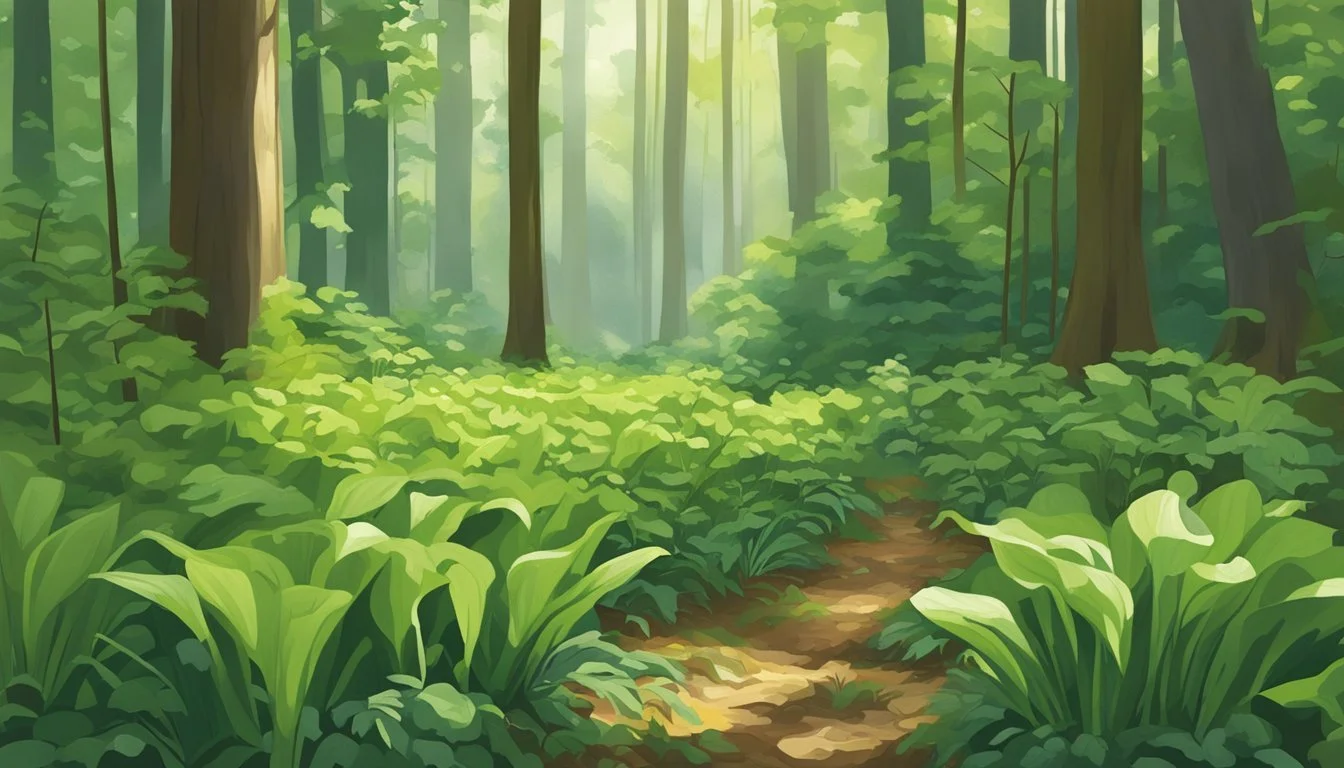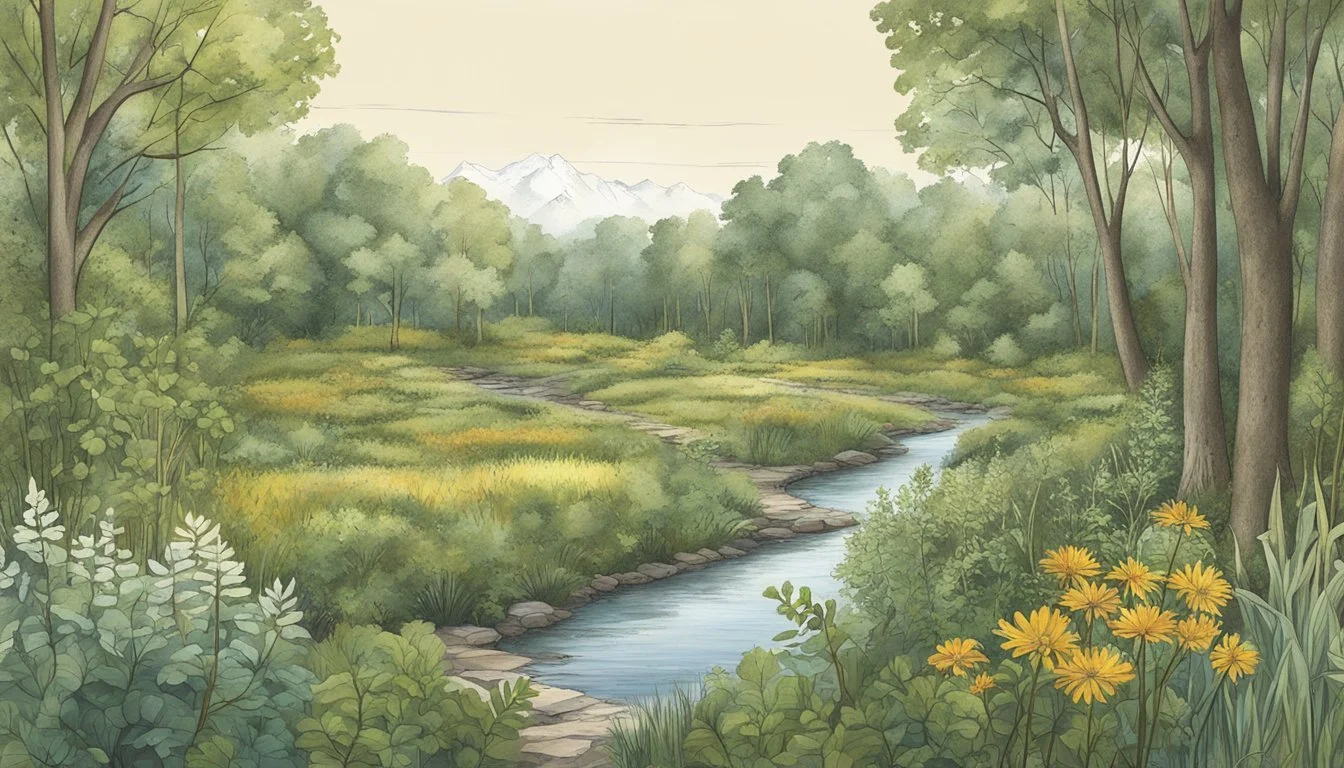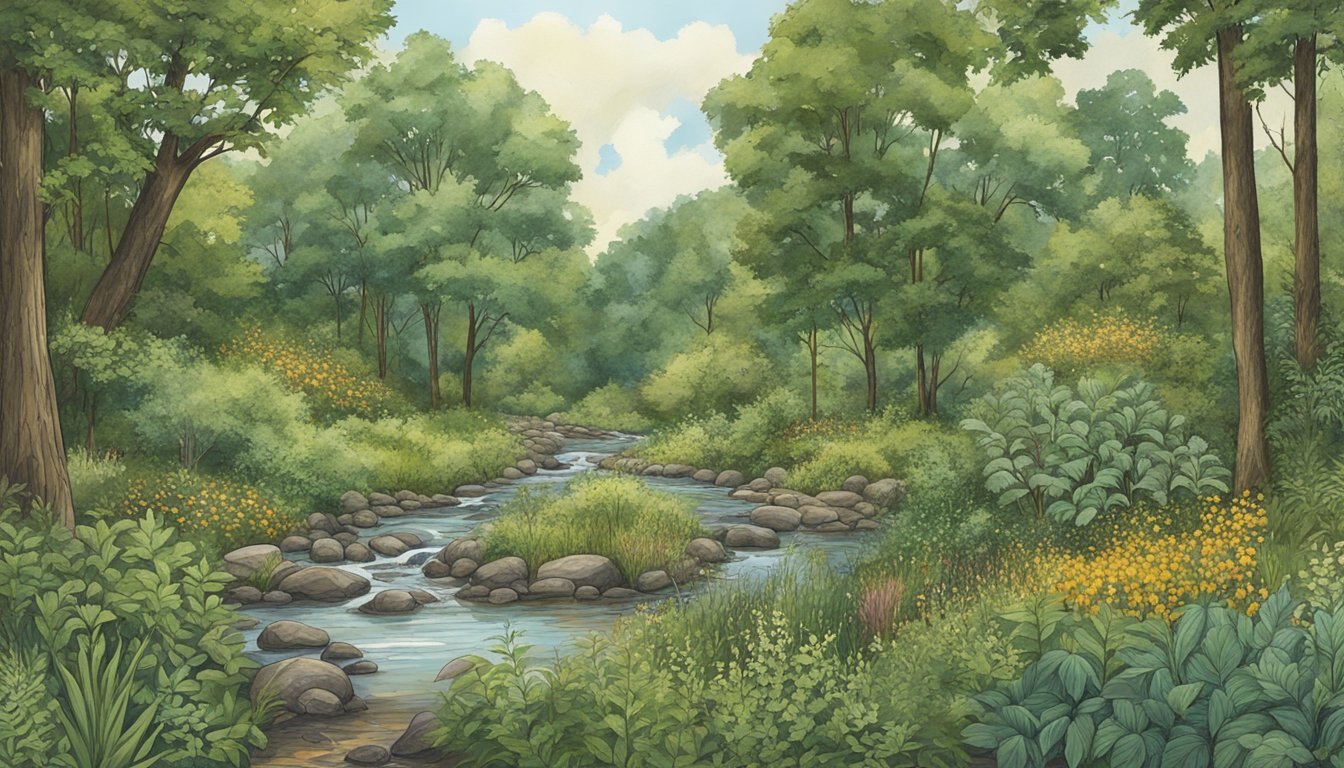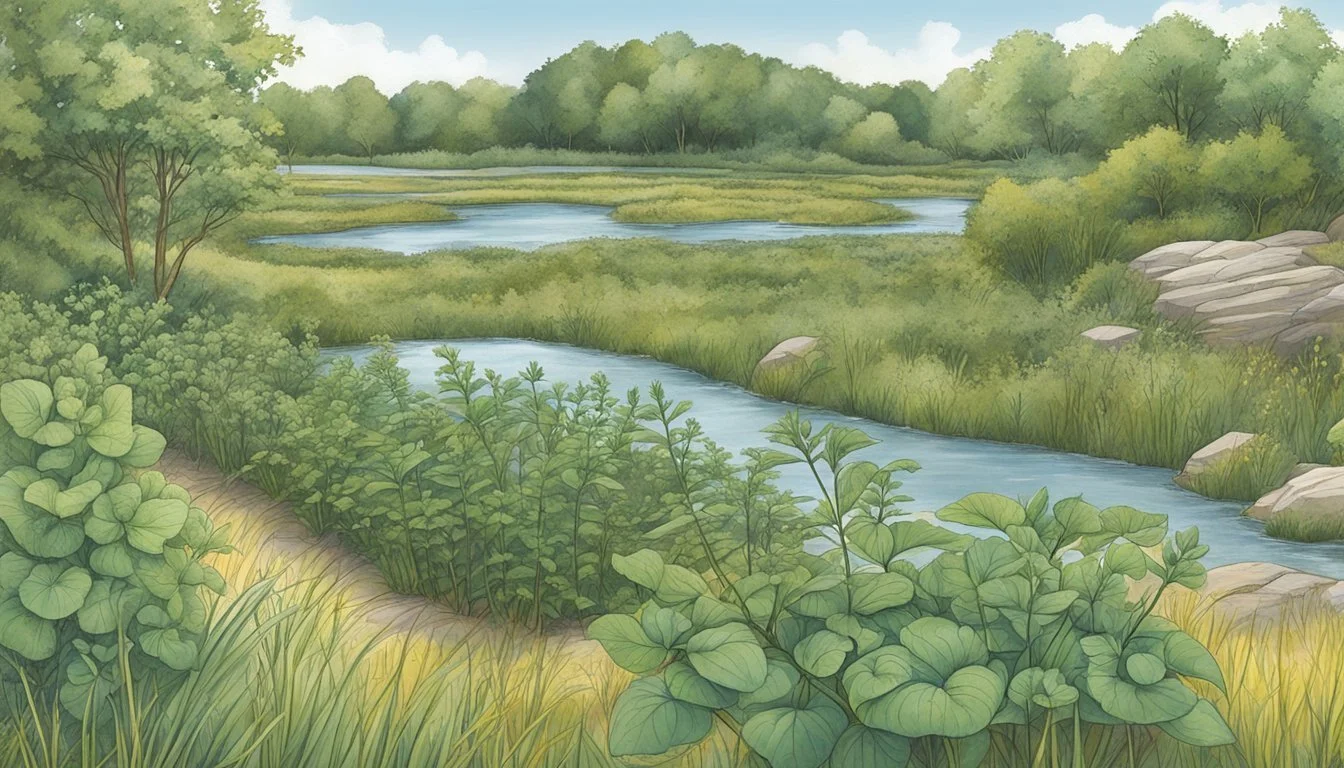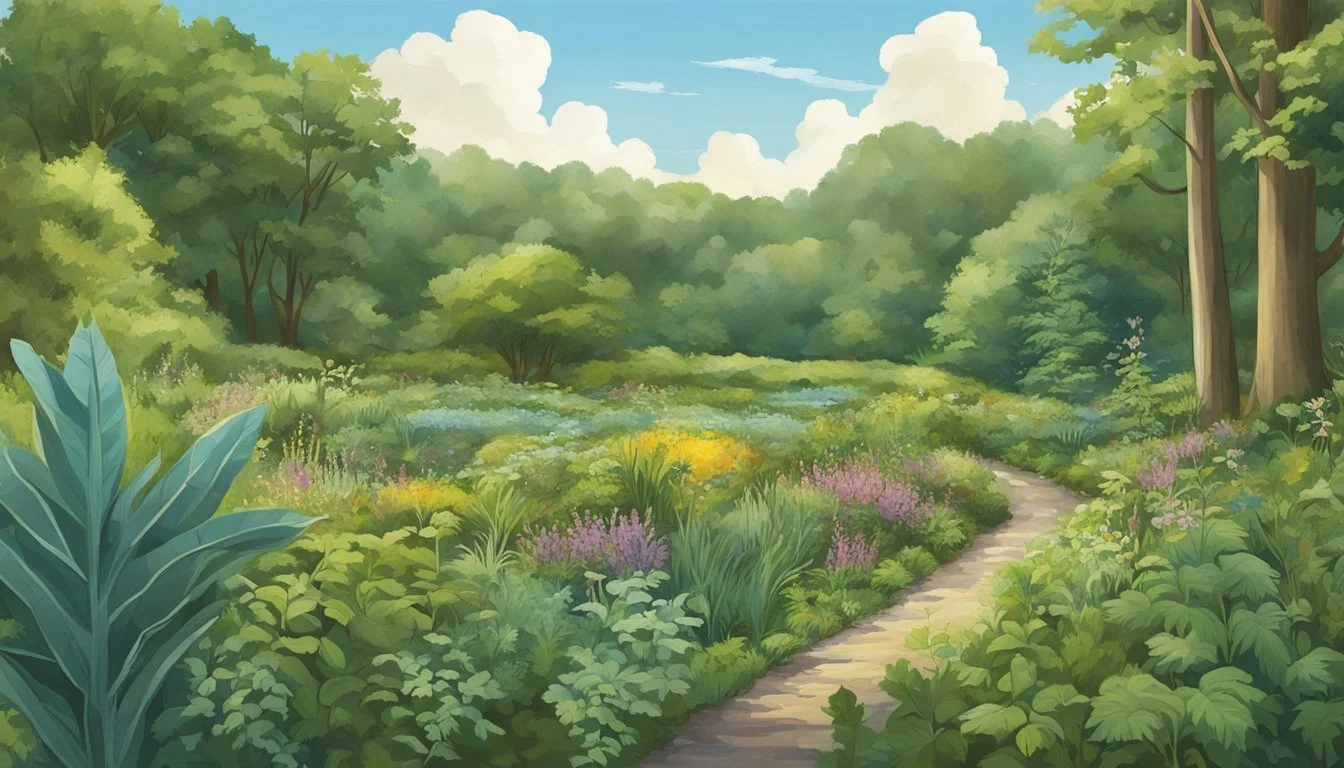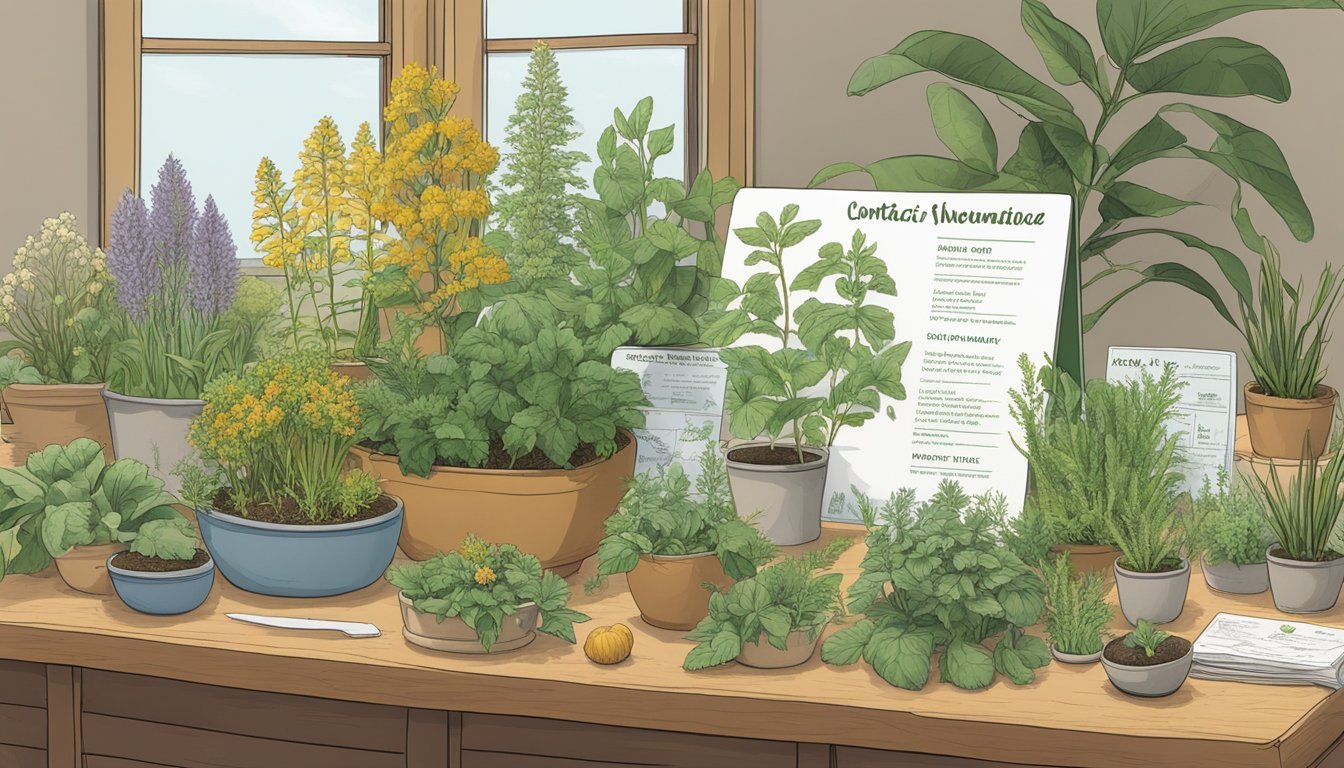Native Edible Plants in Indiana
A Guide to Foraging Locally
This Article is Part of Foraging Guide for All 50 US States
Indiana, with its diverse landscapes ranging from prairies to hardwood forests, is home to an abundance of native plants that have sustained its various populations for millennia. Many of these plants offer more than just scenic beauty—they also provide nutritious and flavorful food sources. Foraging for edible plants is a practice that not only connects individuals with the environment but also offers a deeper appreciation of the state's natural heritage.
The knowledge of edible plants in Indiana is extensive, reflecting a deep connection to the land that is shared among Native American tribes, naturalists, and foraging enthusiasts. In modern times, this knowledge supports a growing interest in sustainable living and natural diets. Plants such as pawpaw, wild ginger, and persimmon are not only important for wildlife but also hold significant value for human consumption due to their nutritional content.
Exploration of Indiana's edible flora is both a culinary adventure and a means to understand the ecological significance of native species in local ecosystems. While some plants like the morel mushroom are widely celebrated for their taste and are foraged extensively, others remain undervalued despite their potential contributions to food diversity and security. By respecting sustainable foraging practices and learning about these plants, people can enjoy Indiana's native bounty while contributing to the conservation of the state's botanical heritage.
Interested in Mushroom Hunting in Indiana?
Indiana's diverse forests and abundant rainfall make it a prime location for mushroom hunting. From the Hoosier National Forest to the state's numerous parks, Indiana offers a variety of edible species, including morels, chanterelles, and chicken of the woods. With proper identification skills and respect for regulations, foraging in Indiana promises a rewarding adventure.
👉 Guide on Mushroom Hunting in Indiana
Historical Context of Foraging in Indiana
In Indiana's rich tapestry, foraging for wild plants serves as a bridge connecting past traditions to present practices. Indigenous inhabitants of this region, such as the Miami, Shawnee, and Potawatomi, traditionally harvested wild edible plants for nutrition, medicinal purposes, and as part of their cultural rituals.
As European settlers arrived in the 18th and 19th centuries, they encountered a diverse range of forageable flora. They learned to identify wild plants, many edible, by observing indigenous foraging habits. This cross-cultural knowledge transfer contributed to the settlers’ survival and culinary variety.
Common wild edibles in Indiana include:
Pawpaw (Asimina triloba)
The largest native fruit in North America.
Mildly sweet and custard-like in texture.
Morel Mushrooms (Morchella spp.)
Highly sought after by foragers.
Distinctive honeycomb appearance.
Ramps (Allium tricoccum)
Wild onion variety; pungent flavor.
A springtime foraging favorite.
In the 20th century, urbanization and industrial growth led to a decline in traditional foraging. However, modern foragers in Indiana have sparked a resurgence, driven by an interest in local and sustainable food sources. They follow strict ethical guidelines, including:
Harvesting sustainably to avoid depleting populations.
Foraging in permitted areas to respect private and protected lands.
Foraging remains a culturally rich activity in Indiana, reflecting a deep understanding and respect for the land's natural resources. It continues to grow, blending historical significance with contemporary environmental consciousness.
Overview of Native Edible Plants
Exploring Indiana's native edible plants uncovers a wealth of natural foods and emphasizes the understanding of their identification, benefits, and seasonal availability.
Identifying Edible Plants
One must approach the identification of edible plants with caution, relying only on verified resources to ensure accuracy and safety. Field guides and local experts can provide assistance. Features to consider include:
Leaf shape and arrangement
Flower color and pattern
Stem characteristics
Root system
Benefits of Native Plants
Native plants of Indiana provide ecological advantages by supporting local wildlife and maintaining biodiversity. They are often hardier and require less maintenance. Notable benefits include:
Enhanced ecosystem health: Native plants support pollinators and other wildlife.
Reduced care: They are well-adapted to local soil and climate conditions.
Nutritional value: Many native plants offer a range of vitamins and minerals.
Common Wild Edibles
Indiana's landscapes are home to numerous native edibles. Some of the common ones include:
Pawpaw (Asimina triloba): A fruit-bearing tree with mango-like flavor.
Persimmon (Diospyros virginiana): Produces sweet, orange fruits.
Wild Bergamot (Monarda fistulosa): Leaves and flowers with a minty flavor.
Seasonal Availability
The availability of wild edibles in Indiana varies by season, dictating the best times for foraging. A simplified seasonal guide is as follows:
Spring: Young greens and shoots such as wild onions and ramps.
Summer: Berries like blackberries and wild strawberries, and herbs like lamb's quarters.
Fall: Nuts (how long do nuts last?) such as black walnuts and hickory nuts, and fruits like persimmons.
Winter: Limited; some roots and bark can be used, but knowledge is crucial for safe foraging.
Foraging Guidelines and Ethics
Foraging for wild edible plants in Indiana requires adherence to legal regulations, sustainable practices, and safety considerations to protect both the forager and the environment.
Foraging Legally
Indiana foraging laws:
Before foraging, individuals must secure permission from landowners or public land managers. Public lands may have specific rules to follow, and some areas may be off-limits to foraging.
State Parks: Foraging is often prohibited.
National Forests: Permit may be required.
Private Property: Obtain explicit permission.
Sustainable Harvesting Practices
To forage sustainably they should take only what they need and use the "1 in 20" rule where one only harvests one plant out of every twenty found, to avoid overharvesting a specific area.
Leave no trace: Be mindful of where they step.
Selective Harvesting: Cut, don't uproot.
Seasonality: Only forage during appropriate seasons to ensure plants can replenish.
Foraging Safety Tips
Identify plants with certainty: Misidentifying plants can lead to consuming toxic species.
Avoid polluted areas: Steer clear of plants near roadsides or polluted waters.
Allergy Awareness: Be aware of personal allergies and carry antihistamines if necessary.
Nutritional and Medicinal Uses
In Indiana, native edible plants offer more than just sustenance; they present a plethora of health benefits and have been traditionally used for their medicinal properties.
Health Benefits of Wild Edibles
Native plants and wild edibles in Indiana are sources of essential nutrients. For instance, many wild berries contain high levels of antioxidants and vitamin C. Wild spinach, often referred to as lamb's quarters, is another example, offering significant amounts of vitamins A and C, calcium, and iron.
Antioxidants: Berries such as blackberries, wild strawberries, and elderberries.
Vitamins: Wild spinach provides vitamins A and C.
Minerals: Plants like nettles are rich in calcium and magnesium.
Common Medicinal Plants
Medicinal plants found across Indiana have been used by Native Americans and early settlers for health care.
Echinacea: Known for immune support, it is used to fight infections.
Wild Bergamot: This plant's leaves are brewed into a tea traditionally used to treat headaches and digestive issues.
It is essential for foragers and consumers to correctly identify and understand the proper use of these plants to ensure safety and efficacy.
Habitats and Growing Conditions
Understanding the specific habitats and growing conditions of Indiana's native edible plants is essential for their successful cultivation and conservation.
Soil and Water Requirements
Native edible plants in Indiana thrive in a variety of soil types, which are often specific to each plant. For instance, the Pawpaw tree prefers rich, well-drained soil, while the Wild Bergamot prospers in dry conditions. The water requirements can also differ significantly:
Pawpaw (Asimina triloba): Moist, well-drained soils
Wild Bergamot (Monarda fistulosa): Dry to medium moisture levels
Sunlight and Shade Tolerance
Sunlight and shade tolerance varies among Indiana's native edibles. Distinct patterns emerge when examining individual species:
Jerusalem Artichoke (Helianthus tuberosus): Full sun
Ramps (Allium tricoccum): Partial to full shade
These plants have adapted to their local environments, demonstrating a range of tolerances that reflect the diversity of the Indiana landscape.
Local Ecosystems
Indiana's local ecosystems are diverse, ranging from hardwood forests to wetlands, each supporting different edible plants. The distinct regions within Indiana such as the Northern Plains and the Southern Hills offer respective environmental conditions for growth:
Hardwood Forests: Home to morel mushrooms and spicebush.
Wetlands: Support species such as cattails and wild rice (how long does wild rice last?).
Each plant species occupies a niche where soil, water, and sunlight conditions meet its survival requirements, contributing to the rich tapestry of Indiana's environmental mosaic.
Culinary Applications
In Indiana, native edible plants offer a vast array of flavors and nutritional benefits. They can be incorporated into everyday meals, providing both novelty and tradition in culinary practices.
Cooking with Wild Plants
Pawpaw (Asimina triloba), with its custard-like fruit, is ideal for baking and can be used in desserts or simply eaten fresh. Its tropical flavor profile adds an unusual twist to traditional recipes. For savory dishes, the hickory nut (Carya spp.) is a robust addition, often ground into flour for baking or added to soups. Black walnuts (Juglans nigra) can be pressed into oils or used as a bold accent in baked goods and confectioneries, notable for their rich, earthy flavor.
Elderberry (Sambucus canadensis) is commonly transformed into syrups or jellies and is a staple for immune-boosting tonics.
Wild greens, such as dandelion and violets, are delightful in salads or as garnishes, while their leaves add depth to pesto variations.
Preservation Techniques
Preserving the harvest of native edible plants extends their culinary usage beyond their growing season. Elderberries are frequently dried, frozen, or turned into wine, which can then be sipped on its own or blended into a unique Indiana gin for a regional twist.
Plant Preservation Method Culinary Use Pawpaw Freezing, pureeing Ice creams, smoothies Black Walnut Drying, pickling Baking, garnishing Hickory Smoking, curing Soups, nut butters
The long-standing tradition of canning is especially suitable for turning wild fruits and berries into jams and preserves, allowing the flavors of Indiana's native flora to be enjoyed year-round.
Potential Threats to Native Flora
Indiana's native plants are integral to its environment, providing essential habitat for wildlife and contributing to the ecosystem's health. However, critical threats like invasive species and pests, along with diseases, can disrupt this delicate balance.
Invasive Species
Invasive species in Indiana are non-native plants that can outcompete, displace, or bring about the decline of indigenous flora. Key offenders include:
Asian Honeysuckle (Lonicera maackii): This plant quickly dominates areas by outcompeting native understory shrubs and herbaceous plants.
Purple Loosestrife (Lythrum salicaria): It invades wetlands, displacing native vegetation vital for local wildlife.
Efforts to control these invasive species often involve mechanical removal, chemical treatments, and the encouragement of biological controls, such as introducing natural predators that specifically target the invasive plants without harming the native ones.
Pests and Diseases
The presence of pests and diseases can severely impact native plants in Indiana's environment through defoliation, competition for resources, or the spread of pathogenic infections. Some of the primary culprits include:
Emerald Ash Borer (Agrilus planipennis): An insect that has devastated ash tree populations by boring into the wood and disrupting the trees' ability to transport water and nutrients.
Gypsy Moth (Lymantria dispar): This moth's larvae consume the foliage of many tree species, weakening them and making them more susceptible to other stresses.
The state employs various strategies to manage and mitigate the impacts of these pests and diseases, such as surveillance programs to detect and respond to outbreaks, the release of biocontrol agents, and public awareness campaigns to prevent the spread.
Ethnobotanical Perspectives
In Indiana, the relationship between indigenous populations and local flora encompasses deep-rooted knowledge and cultural significance. These distinct perspectives illuminate the traditional uses and esteem held for edible plants.
Indigenous Knowledge
Indigenous tribes, such as the Miami and Potawatomi, possessed extensive wisdom about the region's botanical resources. They recognized a plethora of species for their nutritional and medicinal values. For instance, wild berries—like blackberries and raspberries—were commonly gathered. These tribes had intricate knowledge about the ripening seasons and the ideal locations for harvesting. They used plants like elderberries not just for consumption but also in their healing practices. Specific techniques were also developed for processing and storing these wild edibles, ensuring availability throughout the year.
Cultural Significance of Plants
For Indiana's native cultures, edible plants carried meanings that transcended sustenance. These plants were often entwined with spiritual beliefs and communal rituals. An instance of this can be seen in the ceremonial use of tobacco, which, while not an edible plant, exemplifies the profound spiritual significance of plants in indigenous culture. Food plants, too, shaped seasonal festivals, rites of passage, and were intrinsic to creation stories and folklore. The harvesting of wild edibles was, therefore, not merely a physical act but a deeply spiritual practice, reinforcing a connection to the land and its cycles.
Conservation and Sustainability
The preservation of Indiana's native plants is integral to maintaining the region's ecological health. Strategies for conservation focus on fostering plant diversity and safeguarding the natural habitats that wildlife depend on.
Promoting Biodiversity
Indiana's approach to conserving native edible plants includes the protection of various species to promote ecological diversity. This is achieved through:
Seed Banks: Establishing seed banks to preserve the genetic material of native plants.
Educational Programs: Providing information to the public about native species and their role in the ecosystem.
Restoration Projects: Reintroducing native plants into areas where they have become scarce to ensure a diverse gene pool.
Protecting Wildlife Habitats
Conservation efforts in Indiana are also aimed at maintaining and improving habitats essential for wildlife. This involves:
Land Management: Implementing sustainable practices that benefit both flora and fauna.
Legal Protections: Enforcing laws that prohibit the destruction of critical habitats.
Partnerships: Collaborating with local organizations to create protected areas where native plants and wildlife can thrive.
By prioritizing these actions, Indiana works to create a balance between human activity and natural ecosystems, ensuring the sustainability of its native plants and the environment as a whole.
Community and Urban Foraging
In Indiana, the practices of community gardening and urban foraging for edible wild plants are gaining traction as sustainable and local sources of food.
Community Gardens
Community gardens across Indiana serve as hubs for residents to cultivate edible plants, including native species. These gardens are often established on public lands like parks or schools, and provide an opportunity for individuals to learn about horticulture and local flora. Organized through neighborhood groups or nonprofits, community gardens not only offer space for growing food but also foster a sense of community and shared knowledge about urban foraging.
Locations: Spread throughout urban areas, from Indianapolis to smaller cities.
Plants: Key focuses include native berries, greens, and roots used in local cuisines.
Education: Workshops on identification and cultivation of edible wild plants.
Foraging in Urban Areas
Foraging in urban areas like city parks, along roadsides, and within public right-of-ways in Indiana is an emerging trend. Urban foragers seek out edible wild plants that thrive in these environments, while also adhering to safety and sustainability guidelines to protect themselves and the ecosystem. Urban foraging in Indiana is not only about food discovery but also about reconnecting with the land and local food sources.
Common Edible Wild Plants: Dandelions, wild onions, lamb's quarters, and berry bushes.
Safety Considerations: Awareness of potential contaminants from nearby roads or industrial areas.
Legal Restrictions: It is critical for foragers to know the regulations regarding plant harvesting in their specific urban locale.
Aspect Consideration Safety Always forage away from roadsides to avoid pollution. Regulations Understand local laws and ordinances on foraging in public spaces. Sustainability Harvest responsibly to ensure plant populations remain for future generations. Identification Accurate plant ID is crucial to avoid toxic species and unlawful removal.
Field Guides and Resources
In the search for knowledge about Indiana's edible wild plants, enthusiasts turn to several authoritative guides and resources. The most recommended books include "Edible Wild Plants: A North American Field Guide" by Thomas S. Elias and Peter A. Dykeman, which offers insights into plant identification, and "A Field Guide to Edible Wild Plants: Eastern and Central North America" by Lee Allen Peterson, providing a detailed look at species prevalent in Indiana.
Local resources such as the Indiana Native Plant Society (INPS) offer publications and online materials focused on the region's flora. Their resource lists often suggest guides specific to edible plants in Indiana’s diverse habitats.
Resource Type Examples Books "Edible Wild Plants: A North American Field Guide"; "A Field Guide to Edible Wild Plants: Eastern and Central North America" Local Societies Indiana Native Plant Society Online Databases USDA Plants Database Workshops and Field Trips Offered by local nature centers and botanical gardens
Online databases such as the USDA Plants Database provide a digital means to precise identification and understanding of plant species. To complement reading, Indiana's botanical gardens and nature centers conduct workshops and field trips. These hands-on opportunities allow individuals to experience the identification and harvesting of wild edibles under expert guidance. Learning about edible plants in Indiana combines the utility of books with the localized knowledge from societies and practical experience in the field.
Legal and Policy Framework
Indiana maintains a series of laws and regulations that govern the foraging, cultivation, and sale of native edible plants. Regulations are designed to protect both the environment and the interests of property owners, while also preserving Indiana's natural heritage.
Foraging Rules and Regulations:
Public Lands: Foraging on public lands may require permits. It is illegal to forage in state parks without explicit permission.
Protected Species: Certain plants are protected by law and cannot be foraged.
Private Property: Foraging on private property is only legal with the consent of the owner.
Cultivation and Trade:
Native Plant Nursery Certification: Nurseries must be certified to sell native plants.
Invasive Species Regulation: It is prohibited to plant species recognized as invasive, which can displace native edible plants.
Enforcement and Penalties:
Regulatory bodies like the Indiana Department of Natural Resources (DNR) enforce these policies. Penalties range from fines to criminal charges, depending on the violation's severity.
Environmental and Conservation Laws:
Indiana enforces environmental laws that indirectly affect native edible plants by preserving ecosystems. The state supports the conservation of wild areas through various initiatives, which include:
Habitat preservation efforts
Biodiversity conservation plans
Sustainable land-use practices
Each of these regulations and conservation efforts work in tandem to safeguard Indiana's native edible plants, ensuring their availability and sustainability for future generations.
Workshops and Educational Programs
Indiana boasts a variety of educational programs on native edible plants, geared towards fostering skills in foraging and plant identification. The Indiana Foraging Society offers workshops throughout the year, with an emphasis on safety and sustainability. These events usually include a hands-on component, where attendees can experience identifying and harvesting local flora under expert guidance.
Local Nature Centers and Botanical Gardens such as the Hoosier National Forest and the Indianapolis Zoo also conduct seasonal programs. These facilities provide structured courses designed to educate individuals on native species and their uses.
Location Program Types Frequency Indiana Foraging Society Workshops, Field Trips Monthly Hoosier National Forest Guided Foraging Walks Seasonal Indianapolis Zoo Educational Talks, Demonstrations Quarterly
Educational institutions, like Purdue University’s Extension Office, offer resources for residents interested in foraging. They sometimes collaborate with local experts to deliver classes that cover topics such as plant identification, ethical harvesting principles, and culinary uses.
Public libraries across the state occasionally host talks by authors and foraging enthusiasts. Aspiring foragers can take advantage of these sessions to expand their knowledge base and connect with fellow nature aficionados.
Community bulletin boards, both physical and online, are rich resources for discovering upcoming workshops. Social media platforms, specifically dedicated to Indiana's foraging community, serve as hubs for sharing information about such educational events.
Frequently Asked Questions
What edible plants can be foraged in Indiana?
Pawpaw
Persimmon
Wild Ramp
Morel Mushrooms
When is the best time to forage for edible plants in Indiana? Spring and fall are prime seasons for foraging due to a variety of plants being in the ideal stage for harvest.
Where in Indiana can foragers find these plants?
Most are available in wooded areas, but foragers should always seek permission if the land is private and check regulations if it's public.
Are there courses on foraging in Indiana? Yes, local nature centers and conservation groups offer workshops.
What precautions should foragers take?
Identify plants accurately using a guide or expert.
Understand sustainable harvesting to protect ecosystems.
Never eat a plant unless they are 100% sure of its identity.
What are the legal considerations for foraging in Indiana? They should be aware of state and local laws, as some areas may have restrictions or require permits for foraging.
Conclusion and Future Directions
In Indiana, foraging for native edible plants has seen a resurgence of interest due to its environmental and health benefits. Individuals and organizations are increasingly recognizing the potential these plants have, not only in their natural habitats but also in urban settings.
Awareness: Boosting awareness through educational programs could further enhance the appreciation of Indiana's native edible flora.
Conservation: Sustainable foraging practices are essential in preserving native species for future generations.
Identification & Use
Prospects for future foraging activities in Indiana are promising with a growing number of resources aiding in accurate plant identification and usage. Carefully curated guides and workshops provide foragers with the necessary knowledge to distinguish between safe and hazardous species.
Integration into Cuisine
Trends in local cuisine have begun incorporating foraged edibles, which may support local economies and sustainable food practices. By integrating these native plants into their menus, chefs can help to popularize their use and create a market for locally foraged products.
Research & Cultivation
Continued research into the cultivation of native edibles could pave the way for more diverse agricultural practices in Indiana. Experimentation with domesticating wild species can help meet future food demands while maintaining ecological balance.
Collaboration: Partnerships between foragers, conservationists, and agronomists can drive innovation in the utilization of edible native plants.
Policy: Development of policies to manage foraging rights and responsibilities will be crucial in ensuring that interest in native plants is matched with commitment to ecosystem health.
In conclusion, the future of Indiana's edible native plants hinges on education, sustainable practices, and the development of a supportive community around foraging.
Appendix
Glossary of Common Terms
Foraging: The act of searching for and collecting wild food resources.
Perennial: A plant that lives for more than two years.
Edible: Fit to be eaten as food.
Botanical Name: The scientific name given to a plant according to the system of nomenclature used in botany.
Habitat: The natural environment in which a plant or animal species lives.
Selected Native Edible Plants in Indiana
Common Name Botanical Name Habitat Notes Pawpaw Asimina triloba Understory tree in wooded areas Persimmon Diospyros virginiana Found in forests and field edges Wild Ramp Allium tricoccum Common in rich, moist woodlands Black Walnut Juglans nigra Grows in mixed hardwood forests Elderberry Sambucus canadensis Thrives in a variety of habitats
References
Indiana Department of Natural Resources. (n.d.). Indiana's Edible Wild Plants. Retrieved December 16, 2023
Millspaugh, C. F. (1974). American Medicinal Plants. Dover Publications.
Peterson, L. A. (1977). Peterson Field Guides: Edible Wild Plants. Houghton Mifflin Harcourt.
For further research and education on Indiana's native plants, interested individuals are encouraged to refer to the cited references and resources offered by local naturalist societies and extension services.
About the Author
The author, Dr. Jane Maple, is an expert in regional botany with a focus on the edible flora of the American Midwest. Holding a Ph.D. in Botanical Sciences from Indiana University, she has dedicated over 20 years to studying and teaching about the indigenous plants of Indiana.
Education: Ph.D. in Botanical Sciences, Indiana University
Experience: 20+ years in regional botany research
Specialization: Native edible plants of the Midwest
She has conducted numerous field studies and has a deep understanding of the ecological narratives of Indiana's native species. Dr. Maple's work includes collaborating with local foraging groups to promote sustainable harvesting practices.
Publications: Over 30 journal articles on native plants
Awards: Indiana Botanical Society's 'Botanist of the Year' (2021)
In her current role, she serves as a consultant for state parks in Indiana, where she helps design educational programs on edible native plants for visitors. Her aim is to foster greater appreciation for local ecosystems and their culinary potential.
Current Role: Consultant for Indiana state parks
Outreach: Educational programs on native plants
Dr. Maple's approach is empirical and practical, offering clear instructions on how to identify and use edible plants safely. Her confidence and expertise make her a trusted voice in the field of indigenous botany.
Contact Information
For those interested in learning more about native edible plants in Indiana, a number of organizations and experts can provide valuable information and guidance. Below is a list of contacts that can assist with inquiries on cultivation, identification, and uses of Indiana's native edibles.
Indiana Native Plant Society (INPS)
Phone: (317) 356-8808
Address: 1050 E 52nd Street, Indianapolis, IN 46205
Purdue Extension
Email: extension@purdue.edu
Phone: (888) EXT-INFO or (888) 398-4636
Local Offices: Available across all counties in Indiana
University Experts Contact Method Dr. Jane Doe, Ethnobotanist jane.doe@university.edu Prof. John Smith, Agriculture john.smith@agri.edu Dr. Alice Brown, Horticulture alice.brown@hortiuni.edu
Public Libraries in Indiana
Libraries often carry resources on indigenous plants and can direct you to local experts.
Contact your local library branch for their collection on Indiana's native edible plants.
Indiana Department of Natural Resources (DNR)
For information on conservation and guidelines regarding foraging:
Website: www.in.gov/dnr
Phone: (317) 232-4200 or (877) 463-6367
Anyone reaching out for information should verify the current status of the contact details, as they are subject to change.
Acknowledgments
This section expresses gratitude to the many individuals and organizations that have contributed their expertise and knowledge to the compilation of native edible plants in Indiana.
Organizations:
Indiana Department of Natural Resources: Their botanists provided invaluable insights into the native flora.
Native Plant Society of Indiana: Members shared their hands-on experience with plant identification and usage.
Experts:
Dr. Susan Clearwater, ethnobotanist: For her guidance on the historical uses of indigenous plants.
Professor John Greenfield, ecologist: For assistance with ecosystem contexts for plant species.
Communities:
The local foraging groups throughout Indiana who generously collaborated on verifying plant locations and availability.
Volunteers:
A special thanks to volunteers who dedicated time to survey and document the plants within their local environments.
This work was also made possible with the support of various educational institutions across Indiana for their in-depth research materials concerning the state's diverse botany.

